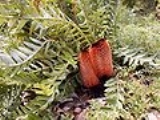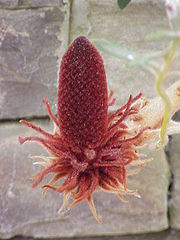
Banksia blechnifolia
Encyclopedia
 |
 |
Banksia blechnifolia is a species
Species
In biology, a species is one of the basic units of biological classification and a taxonomic rank. A species is often defined as a group of organisms capable of interbreeding and producing fertile offspring. While in many cases this definition is adequate, more precise or differing measures are...
of prostrate shrub
Prostrate shrub
A prostrate shrub is a woody plant, most of the branches of which lie upon or just under the ground, rather than being held erect as are the branches of most trees and shrubs....
in the plant
Plant
Plants are living organisms belonging to the kingdom Plantae. Precise definitions of the kingdom vary, but as the term is used here, plants include familiar organisms such as trees, flowers, herbs, bushes, grasses, vines, ferns, mosses, and green algae. The group is also called green plants or...
genus
Genus
In biology, a genus is a low-level taxonomic rank used in the biological classification of living and fossil organisms, which is an example of definition by genus and differentia...
Banksia
Banksia
Banksia is a genus of around 170 species in the plant family Proteaceae. These Australian wildflowers and popular garden plants are easily recognised by their characteristic flower spikes and fruiting "cones" and heads. When it comes to size, banksias range from prostrate woody shrubs to trees up...
. Found in sandy soils in the south coastal region of Western Australia in the vicinity of Lake King, it is non-lignotuber
Lignotuber
A lignotuber is a starchy swelling of the root crown possessed by some plants as a protection against destruction of the plant stem by fire. The crown contains buds from which new stems may sprout, and a sufficient store of nutrients to support a period of growth in the absence of...
ous, regenerating by seed after bushfire. It gained its specific name as its leaves are reminiscent of fern (blechnum) leaves.
Description
Banksia blechnifolia is a prostrate shrub with thick horizontal stems and vertical leathery herringbone leaves rising some 20 cm high. New growth is covered with orange brown hair. The inflorescenceInflorescence
An inflorescence is a group or cluster of flowers arranged on a stem that is composed of a main branch or a complicated arrangement of branches. Strictly, it is the part of the shoot of seed plants where flowers are formed and which is accordingly modified...
s are golden or pinkish brown and flowering is in late spring. As the inflorescences age, they fade to brown and then greyish.
Cultivation
In cultivation, though somewhat resistant to diebackPhytophthora cinnamomi
Phytophthora cinnamomi is a soil-borne water mould that produces an infection which causes a condition in plants called root rot or dieback. The plant pathogen is one of the world's most invasive species and is present in over 70 countries from around the world.- Life cycle and effects on plants :P...
, it does require a well drained soil, preferably fairly sandy. It makes an attractive prostrate groundcover. It appreciates extra water in summer and can be quite vigorous. Overall, it is the easiest Western Australian Banksia to grow in a humid climate.
Seeds do not require any treatment, and take 14 to 49 days to germinate.

